This article aims to give an introduction to the British Armies Clansman radio system deployed between 1978-2005 with details of the principle sets of interest to the radio amateur. In order to give a better understanding of the improvements and facilities offered by Clansman some historical background is included.
The replacement for the famous Wireless Set No.19 MkIII and first in the Larkspur series was, the less well-known Station Radio C12, introduced about 1955.
The C12 has the same physical size as the WS19 with approximately the same working range as the WS19 High Power. Frequency coverage is 1-6-10MHz in two bands with flick-switching between any two independently tuned frequencies. The Larkspur C12 was a commercial model produced by PYE being introduced in the interim period whilst the true Larkspur C13 and C11/R210 were still under development. The C12 employed the much superior Plessey MK4 connectors (later know as Weald LMF range). These have rugged brass bodies that are cadmium plated & passivated. The contacts units are sealed with non-removable silver plated brass contacts. These connectors were used on all of the Larkspur sets. Anyone who has used a WS19 will know that the harness connectors and in particular, the snatch plugs, were very unreliable. Experienced WS19 operators would often carry some sand paper with them to clean the contacts!
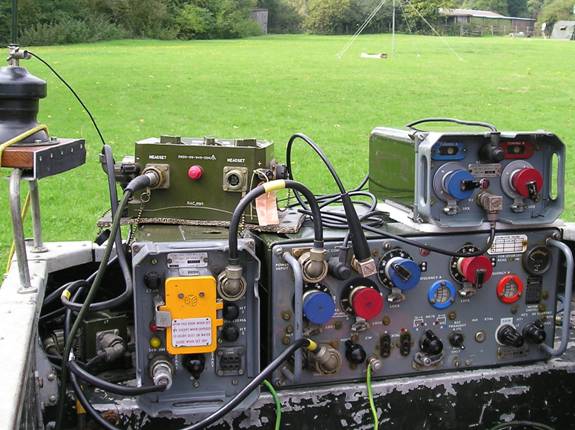
Station Radio C12 seen here during portable operation from a series one Land-Rover
Whilst looking at the C12 its improvement in transmission quality over the WS19 is worth a mention. Those that have heard transmissions from a WS19 will have noticed the characteristic Grid Modulation. The C12 uses high level Anode and Screen modulation, delivered by a pair of STC 5B254M (miniature 807) valves. Together with the balanced armature microphones, made by SG Brown (RACAL Acoustics Ltd) and as used by all of the Larkspur sets the quality of audio is, in communications terms, superb!
When the C12s were eventually replaced, of the 3000 or so used by the British Army, relatively few found their way onto the surplus market. This would appear to be mainly due to the tuner unit’s two roller coaster coils, wound with solid silver wire, being of great interest to the scrap dealers!
The Larkspur Series
Clansman replaced the Larkspur series of radios such as the C11/R210, C13 and C42 etc., these were almost entirely based on valve technology. The Larkspur sets are wonderful examples of 1960s electronic design and were thoughtfully constructed for ease of operational use and servicing.
The Larkspur vehicular or fixed station sets are mostly VFO (Variable Frequency Oscillator) controlled, with frequency readout being from photographic Filmstrip dials. Crystal calibrators were built into the receivers; on HF (High Frequency) fairly accurate frequency setting to any 10kHz increment was possible. Frequency selection between dial calibrations and calibrator markers was a matter of interpolation. Overall frequency setting accuracy was unlikely to be much better than +/-1 kHz. This was normally entirely adequate for AM (Amplitude Modulation) nets and CW (Morse) using the BFO (Beat Frequency Oscillator) control. The vehicular VHF FM (Frequency Modulation) sets such as the C42 employed similar filmstrip tuning with sufficient accuracy for correct tuning to channels spaced at 50kHz using wide deviation FM.
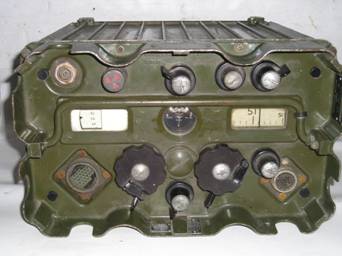
Larkspur C42 Mk 1 FM Transceiver VHF 36-60MHz
With advances in technology Larkspur was approaching the end of its service life and around 1975 was awaiting replacement with Clansman.
In order to interoperate both series of equipment during the changeover period of replacement, Clansman had to employ a degree of compatibility with Larkspur. The design of Clansman HF radios thus incorporated the legacy AM and CW modes. Whilst there was a fully transistorised SSB (Single Side Band) version of the Larkspur C11/R210 made by Mullard (Mullard Electronics Limited, MEL) this used technology that was already obsolescent.
The Clansman HF transceivers all have SSB (Upper Side Band, USB only) capability, which offers much better performance in terms of power input employed. This is a very important consideration for the battery powered manpack radios. The Clansman PRC320 manpack requiring typically less than 150mA (at 24V) on standby receive. The Larkspur sets valve heaters alone use several times this power.
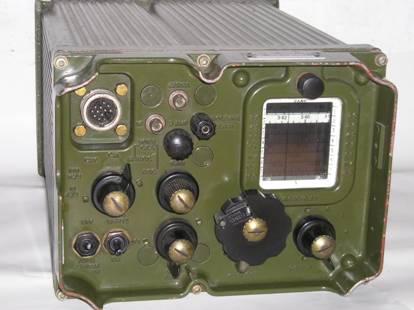
Larkspur HF Receiver R210 (Note the large filmstrip tuning dial)
The Vehicular Sets
With volume production starting in 1977 the first of the new Clansman vehicular sets to be issued to the Army would appear to have been the Transmitter Receiver Radio UK/RT353 also known as the VRC353. This VHF FM Transceiver covers 30-75.975 MHz in 25kHz steps. Manufacture was by Marconi Space and Defence Systems or its various contractors. Later to all be subsumed into British Aerospace Electronics (BAE Systems). This set was designed primarily for fighting vehicles, whilst also being suitable for fixed stations. The transmitter is capable of 50 Watts RF output. This relatively high power, being necessary to help overcome potential interference from enemy jamming. Whilst being mainly transistorised the RT353 has valves in the receiver front end and Transmitter output. This may at first seem outdated but the receiver valves are special low noise types (VX3555 made by STC) and capable of withstanding the high EM (Electromagnetic) pulses from potential nuclear attack. The transmitter uses a special Disc Seal Tetrode capable of working into faulty aerials and questionable loads without damage. It will still deliver 35 W into a load with 2:1 VSWR.
Whilst the RT353 uses valves and about 2 Amps at 24V on receive, as a vehicle radio or base set this was not a particular issue.
Channel frequency setting is accomplished by rotating the large grey control knob after selecting the 10s of MHz 100s of kHz and 25 kHz increment with the concentric control. The transmitter and receiver tuning being achieved entirely automatically by three servomotors controlled in a delta sigma Phase Locked Loop (PLL) system. The PLL is referenced to a temperature compensated crystal oscillator. This ensures frequency is kept to within about 300Hz of selected channel centre for external temperatures between -40 to +55 degrees Celsius!
Whilst being hermetically sealed the RT353 is cooled by two powerful fans that sound like a jet engine when running. Fortunately these only cut in when the unit is running in hot conditions or has been on transmit for an extended period. The designers of the RT353 have isolated the air-cooling channel from the radios internal electronics; this allows immersion in water to a depth of 1.5 metres without damage as required by DEF standard 133.
Together with FM voice mode the RT353 is capable of transmitting data (usually encrypted from a Data Master Unit, DMU) with Adaptor Telegraph Radio (ATR) being used to send Analogue data to 750 bauds or Telegraph to 150 bauds.
The RT353 has several selectable transmit modes with narrow and Wide deviation. The wide mode ensures some compatibility with Larkspur C42 Mk2 and other earlier radios such as the SEM25. The Narrow deviation mode (+/-6kHz), is normally used for FM voice communications, this setting also sends a sub audible 150Hz tone. This tone ensures compatibility with standard NATO VHF sets where its presence is required to open the receiving sets squelch. The nominal 150Hz tone is also needed to trigger automatic re-broadcast, which requires two Clansman sets to be linked together via the harness or two-wire remote link.
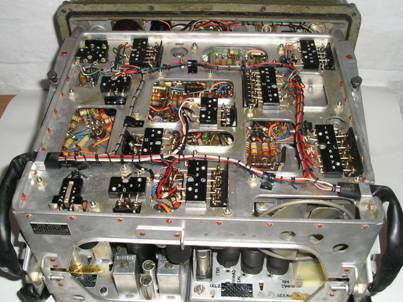
The photograph to the right shows the top chassis of the C42 and tag strips whereby the various modules can be disconnected for quick replacement and service.
Clansman Design Philosophy
It is interesting to study the design of the Larkspur sets, many features of which were followed through to Clansman. Where possible a modular approach to construction was employed, allowing individual modules to be removed for service and replaced with known good units, Clansman also makes extensive use of modules, which in the manpack sets are soldered to the main printed board using wire pins. Key modules such as Power Supplies are connected by plug-in connectors for ease of removal. In the RT353 the relatively complex transmitter and receiver main sections are also plug-in units.
The workshop repair process for Clansman was largely to isolate faults to module level and then change the module with a new or reconditioned unit from stores. Modules were designated as CENTREMS (Centrally Repaired Items) being either returned to the manufacturer or specialist REME unit.
The Clansman radio system employs late 1960s to mid 1970s technology with mainly discrete components and well-known transistors, such as the Pro-Electron coded BCY71, BC107, BSY95A, and a few American JEDEC (Joint Electronic Device Engineering Council) types by RCA etc in power applications. CV marked devices to government DEF and industrial standards such as BS9000 being employed where available. However the equipment did use some state of the art technology from Plessey. With custom pulse width modulation (PWM) control ICs in power supplies, integrated audio signal processing and notably, gold plated surface mount divider ICs in the frequency synthesizer. Accordingly these radios were very expensive, with some of the manpacks alone reputedly costing the government five figure sums.
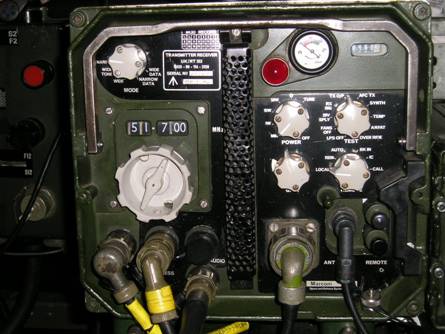
Transmitter Receiver UK/RT353 (VRC353)
HF SETS
The principle HF transceiver was the RT321 (VRC321) manufactured by MEL, covering 1.5-29,999 MHz with AM, CW, & SSB (USB only) modes. Transmitter output is 40 Watts pep. Frequency selection being by a rotary control for 1-29MHz with 100s of kHz, 10s of kHz, kilohertz & finally100Hz decades by separate rotary controls. The concept of simple operation is again the order of the day with all transceiver tuning being automatic. Upon switching on the RT321 or changing frequency the internal motor driven tuning whirs away peaking the tuning for optimum performance within ten seconds.
After a warm-up period of a minute or so the frequency of transmit or receive stabilizes to the internal standard which is a high-grade temperature compensated unit. On correctly adjusted sets frequency stability is impressive and typically within a couple of 10s of Hertz of selected channel. This makes the radio particularly good for SSB and RTTY where accurate tuning and stability is highly desirable.
Unlike the earlier Larkspur sets there is no need at all for crystal calibrators with the RT321 holding its specification between temperatures of –40 to +55 degrees Celsius.
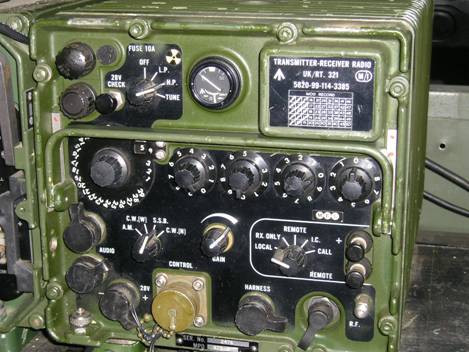
Clansman Transceiver Radio UK/RT321 (VRC321)
Aerial tuning does require manual adjustment but is quickly accomplished with the high quality Roller Coaster TURF (Tuning Unit Radio Frequency). All critical parts of the tuning circuit either being silver or silver-plated. The PTFE roller coaster winds unused silver wire onto a drum which short circuits the inductance not required in circuit.
The standard vehicle antenna for HF operation is either a 3 or 4 metre whip.
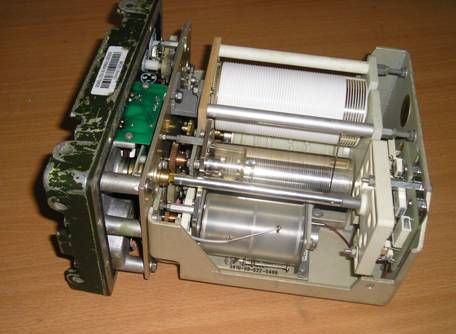
Internal view of TURF 25W showing silver wire tape roller inductor
In part 2 of this series we will take a look at the manpack sets and antenna systems used for vehicle installations. This will include details of the automatic-tuning units, Tuning Unit Automatic Antenna Matching (TUAAM) used with the fixed and portable VHF sets.
Barry
G8DXU
Copyright 04.04.2014
